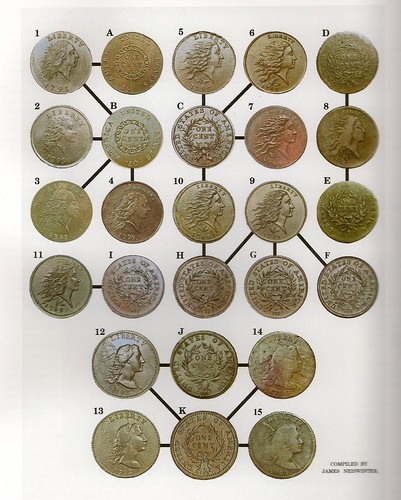
About UsThe Numismatic Bibliomania Society is a non-profit organization promoting numismatic literature. For more information please see our web site at coinbooks.org SubscriptionsThose wishing to become new E-Sylum subscribers (or wishing to Unsubscribe) can go to the following web page link MembershipThere is a membership application available on the web site Membership Application To join, print the application and return it with your check to the address printed on the application. Membership is only $15 to addresses in the U.S., $20 for First Class mail, and $25 elsewhere. For those without web access, write to: David M. Sundman, Secretary/TreasurerNumismatic Bibliomania
Society AsylumFor Asylum mailing address changes and other membership questions, contact David at this email address: dsundman@LittletonCoin.com SubmissionsTo submit items for publication in The E-Sylum, just Reply to this message, or write to the Editor at this address: whomren@coinlibrary.com
BUY THE BOOK BEFORE THE COINYou won't regret it! |
- WAYNE'S WORDS: THE E-SYLUM AUGUST 24, 2008
- LAKE BOOKS: SALE #94 PRL AVAILABLE; SALE #95 CLOSING NOVEMBER 4, 2008
- KOLBE NUMISMATIC LITERATURE SALE #106 CATALOG AVAILABLE
- SKLOW NUMISMATIC LITERATURE SALE #5 CATALOG AVAILABLE
- BOOK IN PROGRESS: JOHN J. FORD AND THE FRANKLIN HOARD
- NEW BOOK: ENCYCLOPEDIA OF SMALL SILVER COINS BY ROGER DEWARDT LANE
- ARTICLE EXPLORES THE 1869 AJN LEVICK PLATE OF 1793 CENTS
- NOTES FROM E-SYLUM READERS
- QUERY: METAL DETECTORIST FINDS J.L POLHEMUS COUNTERSTAMP ON FRENCH COIN
- QUERY: WHAT IS THE MARKET FOR CD-ONLY NUMISMATIC BOOKS?
- IRA REED 1907 JAMESTOWN EXPOSITION MATERIAL APPEARING ON MARKET
- CARSON CITY SESQUICENTENNIAL CELEBRATION REPORT
- ERIC NEWMAN: ADDITIONAL INFORMATION ON THE FRANKLIN HOARD $20 USAOG COINS
- QUERY: HOW TO COUNT REEDS ON A COIN'S EDGE?
- STACK'S SEPTEMBER COIN GALLERIES SALE
- IT'S NOT THE OLYMPIC MEDALS, IT'S THE OLYMPIC METTLE
- I.O.U.S.A: NUMISMATIC ICONS & U.S. CURRENCY SIGNERS
- BRITISH ARCHAEOLOGISTS FINDING COINS OF MANY ERAS AT DIG SITE
- FEATURED WEB PAGE: CASTINE AND THE OLD COINS FOUND THERE
WAYNE'S WORDS: THE E-SYLUM AUGUST 24, 2008
 Among our recent subscribers are Jeff Tolson
and Greg Anglin. Welcome aboard! We now have 1,179 subscribers.
Among our recent subscribers are Jeff Tolson
and Greg Anglin. Welcome aboard! We now have 1,179 subscribers.
Some of you have had trouble reaching me via the whomren@coinlibrary.com address. An alternate is whomren@gmail.com.
This week we open with information on the latest numismatic literature sales from Fred Lake, George Kolbe and David Sklow. A new book is in the works on John J. Ford and the "Franklin Hoard", and Rodger dewardt Lane creates a print-on-demand version of his book on small size silver coins. Next, we highlight a great article by Jim Neiswinter on the famous 1869 AJN Levick Plate of 1793 Large Cents.
Queries this week cover a newly discovered J.L. Polhemus counterstamped coin, numismatic books published on CDs, and how to count edge reeds. In follow-ons to earlier E-Sylum items, we learn about 1907 Jamestown Exposition material coming to market, Will Robins provides a report on the Carson City sesquicentennial celebration, and Eric Newman gives us more background on the $20 U.S. Assay Office of Gold forgeries.
In the news are items about a new documentary film and the discoveries of British archaeologists who uncovered coins made centuries apart as the same dig site. And oh, yeah, today's my birthday! Thanks to Nick Graver for remembering.
To learn the difference between two Ira Reeds, read on. Have a great week, everyone.
Wayne Homren
Numismatic Bibliomania Society
LAKE BOOKS: SALE #94 PRL AVAILABLE; SALE #95 CLOSING NOVEMBER 4, 2008
Fred Lake of Lake Books writes:KOLBE NUMISMATIC LITERATURE SALE #106 CATALOG AVAILABLE
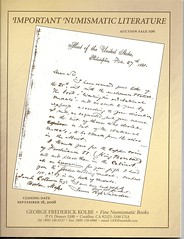 George Kolbe's 106th sale of numismatic
literature closes September 18th, 2008. On the cover is part of lot 493, a
letter to Jeremiah Colburn by Mint Director James Ross
Snowden.
George Kolbe's 106th sale of numismatic
literature closes September 18th, 2008. On the cover is part of lot 493, a
letter to Jeremiah Colburn by Mint Director James Ross
Snowden.From the catalog:
An evocative, most interesting document. Several weeks before standing down as Mint Director, Snowden writes,: "I have received your letter of the 25th inst with the enclosures stated. The book 'Washington and National Medals" will be sent to you by express according to your directions. I will, as requested, put your name on the list of those who desire copies a set of the National Medals, to be struck from the dies in the Mint. I thank you for the copper coins of Ferdinand II (King Bomba) and will place them in the Cabinet. As an honorarium for your gift I send you the "golden wedding" medal. See page 115, no. 47 in my book of medals."
Reflecting the ethos of the day, Snowden clearly had no reservations about restriking medals from Mint dies. In the closing portion of the chapter entitled "A Workshop for Their Gain" (pages 177-192 in The U. S. Mint and Coinage , New York, Arco Publishing Company, 1966), Don Taxay observes:
"The 'retirement' of Franklin Peale closed a chapter in the history of scandals which distinguish the second Philadelphia Mint. But that was all it did. Director Snowden, for example, was so intrigued by Peale's collection of coin and medal dies that he soon hatched a scheme of his own. Snowden wished to complete the collection of Washington medals in the Mint cabinet, and to augment the modest appropriation set aside for this purpose, he ordered the restriking of rare coins and patterns which had trade value."
While nowadays such practices are viewed with disdain in many numismatic quarters, one may ponder if the current striking of a plethora of United States coins for profit or pet fundraising efforts differs in any meaningful degree. At least in the old days no new dies need be engraved!
Snowden served as Director of the Mint from June 1863 until April 1861, and claimed authorship for two major 1861 American numismatic works: the one cited in the letter and his even more popular Mint Manual.
SKLOW NUMISMATIC LITERATURE SALE #5 CATALOG AVAILABLE
 David Sklow's 5th sale of numismatic literature
closes October 4, 2008. The cover features a photo of the old Philadelphia
Mint (lot 250).
David Sklow's 5th sale of numismatic literature
closes October 4, 2008. The cover features a photo of the old Philadelphia
Mint (lot 250).From the catalog:
The stamp of R. NEWELL & SONS, COMMERCIAL PHOTOGRAPHY, STUDIO ON GROUND FLOOR, 255 South 6th Street, Entrance on Manning St., PHILADELPHIA. There is a line drawn through Newells name. Below the Newel stamp is the stamp of Culver Pictures, Inc. 150 West 22nd Street, Suite 300, New York, New York, 10011 (212) 645-1672 and below that is the statement:
This picture is loaned for one reproduction only. Must not be used for advertising without written permission. Original must be returned within 30 days. Obligatory Credit Line, Culver Pictures. Two numbers appear on the reverse also: 049334 and CH4737. Written in pencil toward the top in a circle is Oct. 1922. Culver Studios misattributed the photo to 1922. This photograph is the image that was used in Frank H. Stewarts work, History of the First United States Mint and appears on page 14. It is well documented that Mr. Stewart hired Newells firm to photograph both interior and exterior of the mint.
BOOK IN PROGRESS: JOHN J. FORD AND THE FRANKLIN HOARD
Karl Moulton writes:I'm currently working on a book about John J. Ford, Jr., and the marketing of the "Franklin Hoard" materials. As many already know, Paul Franklin was the one who delivered most of these pieces to Ford, although he was not the source.
There are different versions (from Ford) as to how and when Franklin acquired these items, and it has been difficult trying to determine the truth. My work-in-progress book will provide valid source documents to help clarify this situation. Plans are to have it ready around the end of the year.
NEW BOOK: ENCYCLOPEDIA OF SMALL SILVER COINS BY ROGER DEWARDT LANE
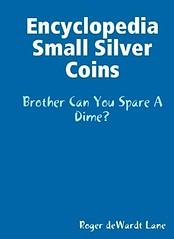 Roger deWardt Lane forwarded the press release
for the newest edition of his book on small silver coins. He writes:
Roger deWardt Lane forwarded the press release
for the newest edition of his book on small silver coins. He writes:
The author Roger deWardt Lane, has published Encyclopedia of Small Silver Coins in two-printed versions, hardbound and soft cover. This anthology and catalog of Modern Dime Size Silver Coins of the World with Footnotes to History has been in preparation for many years. This publication has expanded many details of the limited series of small silver coins of the world from Queen Victoria to 1970. There are interesting small stories, to place these miniature pieces of art into historical context. Over 1000 coin illustrations have been enlarged four times for ease of viewing.
These coins had a monetary value of less than ten cents, when the value of silver was for a hundred years about fifty cents to the ounce. Many empires and nations issued on an annual basis millions of these little miniature silver pieces as subsidiary coinage for their population. Except during times of crisis or war, when species stopped being struck or were hoarded, everywhere people traveled they received these coins in change. Many found their way to the States, only to be saved as mementos or souvenirs of the trip and miss the melting pot. Some eventually reached the numismatic market place. These factors have combined to make these coins available in our time at reasonable prices, rare types excepted.
When this work was first started, the only date listings originally available were in national coin catalogs of the major countries - United States, England and British Colonies, France, Austria, Russia and China and a few others. Around the time of the first drafts, many small country listings and catalogs were issued. In the early 1960-70s, they became the date checklist for the coins added to the collection of the author.
It took many years to research, to transcribe the inscriptions, translate the initials of names, titles, mintmarks, assay initials or marks, and foreign legends, then to find their English translations and expand the text with historical footnotes.
Coin prices are not included, since world economic and political conditions as well as collector interest constantly change the values. The easiest way to find a value of a coin in several condition grades is to make use of the Standard Catalog Series, issued by Krause Publications.
In the mid-1960s computer technology became available on small PCs; so the coin images were scanned in grayscale [looks like silver] with the files stored on removable disks. The software used progressed from Apple to IBM, WordStar to MS-Word. The early printed pages were produced in Adobe PageMaker, later to be exported to Acrobat, which has been uploaded to the printer for these editions.
This current version, 600 pages, b & w, organized in 101 country chapters has over a thousand coin pictures and a like number of century old clip art taken from original history and travel books, which fill the pages with related photos, from Afghanistan to Yemen.
As the old saying goes, a picture is worth a thousand words, look at the preview pages offered on the publishers site www.lulu.com and remember the other famous numismatic quote Buy the book before the coin. Both editions are available thru the Internet and the softcover edition may be ordered through Amazon or your local favorite bookshop.
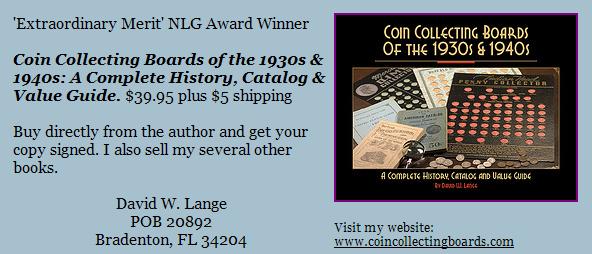
ARTICLE EXPLORES THE 1869 AJN LEVICK PLATE OF 1793 CENTS
In the October 1868 AJN issue, editor Levick wrote:
It seems that Levick was overly optimistic to think he could get all this together for the November AJN, since he received only three responses to his request for cents. Consequently, he had to write individually to every well known collector and anyone else he had heard of who possessed 1793 cents. Some collectors didnt think their pieces were fine enough, but Levick wanted to see all their 93s because he wanted to know of every existing variety. He wanted to make the photographs as complete as possible by showing every variety in the best possible condition.
Many years ago, Eric Newman found these obverse and reverse test photographs loosely laid in his same AJN issue as the regular Levick plate. The writing on the photographs is Levicks. It matches the writing in his journal of the project, The Book of Rubbings, which is in the ANS Library. The first eleven pages of this journal contain pencil rubbings of cents, followed by hand-written text that includes owners names and comments on the coins.
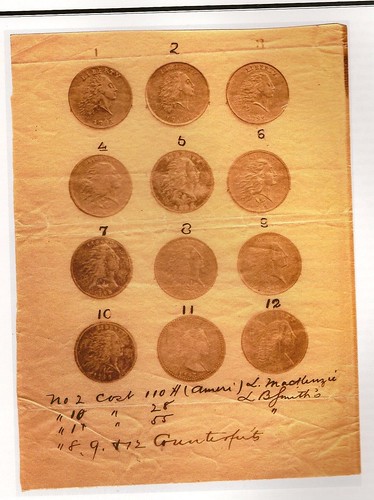
Neiswinter also details different varieties of the plate, and has gone to great lengths to create a modern version (available for $100 through the ANS) with new photographs of top condition 1793 Cents. Congratulations to Jim on the success of his long term project to decipher the history of this landmark in numismatic publishing. -Editor
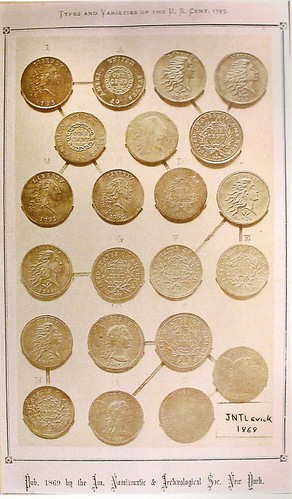
THE BOOK BAZARRE
NOTES FROM E-SYLUM READERS
Subscriber Phil Iverson writes:Nancy Green writes:
The convention was great, but now that I am at the Message Center, I do miss attending the meetings.
Subscriber Jerry Fochtman writes:
I wondered if you'd ever looked into providing a Google-Search into the archives to help locate topics/etc?
QUERY: METAL DETECTORIST FINDS J.L POLHEMUS COUNTERSTAMP ON FRENCH COIN
Web site visitor and new subscriber Jeff Tolson writes:The Polhemus is a nice counterstamp. I used to own several of these. They arent excessively rare, but are popular with collectors. They are listed on p249-250 of Gregory G. Brunks book, Merchant and Privately Countermarked Coins (World Exonumia Press, 2003)
Brunk lists the counterstamp on three different French coins: Fifty Centimes 1850 and Five Francs 1830, 1845. Your silver-dollar sized coin sounds like a Five Franc piece.
Below are links to some Polhemus counterstamps from my collection sold in the 2006 ANR Americana sale. Here's how the cataloguer described Polhemus:
American Numismatic Rarities'
The Lake Michigan & Springdale Collections sale
- Lot
892: Polhemus Counterstamped 1856-S (?) dime
(http://www.stacks.com/lotdetail.aspx?lrid=AN00035898)
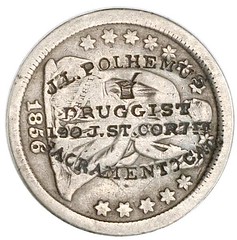
- Lot
901: Polhemus Counterstamped 1856-S quarter
(http://www.stacks.com/lotdetail.aspx?lrid=AN00035897)
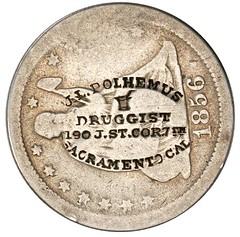
- Lot
902: Counterstamped 1850 British half pound.
(http://www.stacks.com/lotdetail.aspx?lrid=AN00035896)
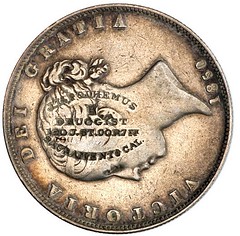
QUERY: WHAT IS THE MARKET FOR CD-ONLY NUMISMATIC BOOKS?
Last week we had a report on the NBS symposium on self-publishing. I've been wondering lately about the market for CD-only numismatic books. Several are available in both book and CD forms, but only a few are produced only in CD format. I'd like to compile a list of them - please let me know of ones, either already "in print" or contemplated. I can be reached at whomren@gmail.com . Thanks! -EditorIRA REED 1907 JAMESTOWN EXPOSITION MATERIAL APPEARING ON MARKET
 Regarding last week's mention of a new book on the
1907 Jamestown Exposition, Alan V. Weinberg writes:
Regarding last week's mention of a new book on the
1907 Jamestown Exposition, Alan V. Weinberg writes:
Then, less than a week later, at the American Political Items (APIC) national convention in Las Vegas, dealer/collector Tom Morton of Northridge California had hundreds of superb condition pinbacks, enameled badges and coins, and other exonumia related to the Expo, all attributed to the Ira Reed estate by Tom.
And just yesterday I noted a Delaware exonumia dealer was offering a unique bronze U.S. Mint medal awarded for a Jamestown exhibit, also attributed to the Ira Reed estate.
So it seems the publication of the book comes on the heels of the acquisition of the Ira Reed Jamestown Expo collection which had laid intact and unknown for many decades. I'm told it turned up on the East Coast. Quite a find!
Curious about Ira Reed, Alan and I contacted Pete Smith, who forwarded the following from his American Numismatic Biographies book.
Married Mary E. Scarborough. They had two daughters. He served on the board of trustees of the Bethany Orphans Home for 35 years. In 1930 he contributed the Reed Baby Cottage to the home.
Dealer in Glenside, Pennsylvania. He conducted 31 auction sales 1935 to 1946 including the 1941 ANA convention sale. Reed is believed to be responsible for 1937 cents and nickels with reeded edges distributed at the 1941 ANA convention. The reeding was applied after the coins left the mint and may have been a "play on words" by Reed. In 1946 he sold out to David Bullowa. He died at home in Glenside, Pennsylvania.
obit: NUM 67 Dec 1954 page 1298
So - how did it come about that a book was just published by an author who died 54 years ago? Is it really the same Ira Reed? I went back to Joe Levine, who set us straight. The author of the book is NOT the same Ira Reed - it's Ira Reed of Alexandria, VA. But the Jamestown material now appearing on the market does come from the author (the Alexandria, VA Ira Reed). Joe will also be selling some of the Reed Jamestown Exposition material. He writes: "I obtained the material from David Strebe who purchased many of Ira's ribbons and badges."
CARSON CITY SESQUICENTENNIAL CELEBRATION REPORT
Ken Hopple, Chief Coiner at the Museum, assisted by his wife Karen Hopple, struck CC medallions on the old Carson City Press No. 1 in both silver and bronze, and packaged them to be sold. Lines extended far out the coining room to purchase the medallions, which were, literally, hot off the press.
A raffle was held, with the first prize of a 2008 $5 Bald Eagle Commemorative donated by Northern Nevada Coin. The grand prize, a framed set of three GSA CC Morgan Dollars from the years 1882, '83, and '84 was donated by Southgate Coins.
The museum was buzzing with activity. The Reno Coin Club had set up a booth with coin displays and were giving out foreign coins. People could pan for gold in a station set up outside the museum, and could keep whatever they found... and there was quite a bit of gold there!
The Coin Education Fair was a huge success. Everyone who attended seemed to have a wonderful time.
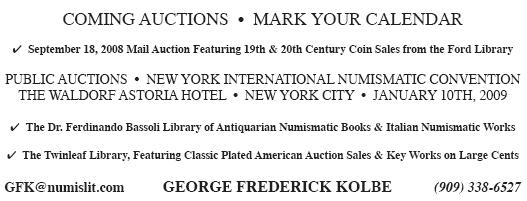
ERIC NEWMAN: ADDITIONAL INFORMATION ON THE FRANKLIN HOARD $20 USAOG COINS
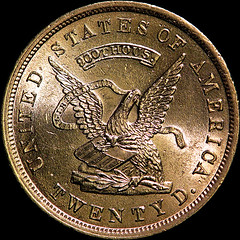 As to conclusions reached on August 2, 2008 in
Baltimore on the topic of the 1853 $20 United States Assay Office of Gold
"proof" coinage sponsored by the Society of Private and Pioneer
Numismatists at the ANA Convention a summary by Don Kagin (organizer) and
comments by George Fuld have been published. I feel I might add some
additional information.
As to conclusions reached on August 2, 2008 in
Baltimore on the topic of the 1853 $20 United States Assay Office of Gold
"proof" coinage sponsored by the Society of Private and Pioneer
Numismatists at the ANA Convention a summary by Don Kagin (organizer) and
comments by George Fuld have been published. I feel I might add some
additional information. Based upon a complaint involving a member of the Professional Numismatic Guild, the PNG in 1966 had arbitration rules under which each party would choose one arbitrator and the two selected arbitrators were to choose the third arbitrator. The three arbitrators were obliged to make a unanimous decision. Paul Garland of Tennessee as a claimant asserted that a "proof" 1853 $20 USAOG coin sold to him in 1965 for $3,000 by Tom Ryan of Illinois was a fake and an arbitration was arranged by PNG in 1966. The first hearing was commenced in Chicago with both sides represented. When Paul Franklin was a witness he was asked the details of the source of the "Franklin Hoard" $20 USAOG pieces including the coin under review. Franklin refused to answer and his representatives asserted that no dealer should be required to disclose his business sources. The arbitrators (none of whom were attorneys) sustained that position. That hearing was recorded but the recordation was either lost or disappeared.
There were further investigations, filings, correspondence and interviews by and with the arbitrators in which each side was able to present material separately but no further hearings were set in which both sides were notified to be present so as to have cross examination or document examination privileges.
During the arbitration proceedings it was pointed out that the coin under review and all other known pieces from the "Franklin Hoard" $20 USAOG pieces had 170 reeds on the edge rather than 164 reeds on previously known 1853 $20 USAOG pieces: and also that on at least one of the "Franklin Hoard" pieces there appeared on the face a thin weak incused compact helical or spiral line which seemed to be on the planchet prior to striking. The helical line was asserted to be have been applied by an automatic crosscut lathe.
There was a difference of opinion in the evidence as to whether such a lathe was available in the 1850s when the alleged planchets were prepared. There was no dispute as to the existence of the helix. It was not asserted that the helix was on the die. The identical dents or bag marks on all of the "Franklin Hoard" $20 USAOG coins were not observed during the arbitration although photography was not then as superb as the imaging is now.
Two of the arbitrators informally agreed that the piece under review was a forgery but the third would not agree. All three arbitrators finally agreed in 1967 that the coin was not a "proof" as stated on the invoice and a decision rendered in favor of Garland against Ryan for $3,000. Ryan refused to pay and in due course suit was filed by Garland in a Cook County, Illinois court to enforce the arbitration decision and judgment obtained. Ryan then paid Garland.
Many years passed before the forgery issue arose again. Some of those asserting forgery included Fuld, Bressett, J. P. Martin, Buttrey, Kleeberg, and Dannreuther. Others continued to urge genuineness. There were several vigorous debates and extensive publications. When the identical dents were noticed about 1994 on all known "Franklin Hoard" $20 USAOG pieces the diagnosis of forgery seemed reconfirmed. Then at the 2008 Baltimore session the prototype piece for the forgeries (containing the same dents and with 164 reeds on the edge) was presented, having been located by a member of Don Kagin's firm. A span of over 40 years was needed to produce general acceptance of forgery of "Franklin Hoard" $20 USAOG pieces.
The proper use of the word "forgeries" in the current findings has been chosen in place of "counterfeits" as had been previously urged because numismatic counterfeits are always fraudulently motivated by a producer in an attempt to substitute them for genuine money in actual circulation rather than a desire to make fakes, copies or reproductions after circulation of genuine pieces had ceased, whether or not to cheat or deceive the collector, student, or researcher.
The creation of the "Franklin Hoard" $20 USAOG pieces really passed a hot potato to the numismatic fraternity.
QUERY: HOW TO COUNT REEDS ON A COIN'S EDGE?
One of the key diagnostics identifying the forged U.S. Assay Office of Gold pieces is the number of reeds on the edge of the coin. But what's the best way to go about counting reeds? It's obvious how to count the number of legs on a buffalo or the number of exposed breasts on a Standing Liberty Quarter. But with reeds on the edge of a coin, which make a complete circle, how do you know when to stop counting?I've never actually done this, but I suppose I would place the coin on a piece of paper, make a tic mark to mark the location of the "first" reed, then go around and count until I reached the end. Being anal retentive, I would probably make a tic mark for every single reed, and perhaps make every tenth mark longer for easier counting.
How do authenticators do it? How do they record their results? If I did this task frequently I might make up cards to record my tic mark counts. These could even be scanned and stored with the coin's computer files. Taking it farther, the coin's edge could even be photographed, but this requires special experience and a setup. Anyway, I'd be curious to know how the pros handle this tedious but crucial task.
STACK'S SEPTEMBER COIN GALLERIES SALE
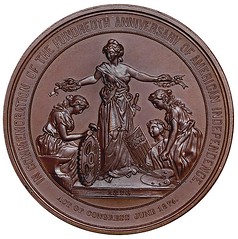
One of my favorite lots in number 1732, an original 1849 Waterloo medal by Pistrucci. From the lot description:
A competition was to be held among artists of the Royal Academy to choose a design, and a work of English artist John Flaxman was chosen. Italian engraver Pistrucci had just been appointed to the Royal Mint and refused to copy the work of another artist. He was then given the total responsibility for the Waterloo Medal, and prepared his first wax model within 24 hours for approval by the Prince Regent, who planned to present gold examples to the Allied sovereigns and the two Marshals.
Pistrucci received the then-enormous sum of 3,500 for this medal, equivalent to some $350,000 in present-day money. He then devoted the next 30 years to incessant squabbling with the Royal Mint administration over his titles and salary. King George IV objected to his florid laureate head on his first coins, but Pistrucci's 1817 Saint George and the Dragon is still employed today on Royal Mint Gold Sovereigns.
Pistrucci finally completed the massive Waterloo dies in late 1849. By now virtually all the recipients had died and the artist soon followed them. The mint was unwilling to risk hardening the long-delayed dies and instead ordered 20 Electrotypes prepared by Mr. Johnson of Bayswater along some in Gutta Percha, a natural resinous material. No struck medals in the original diameter were ever struck.
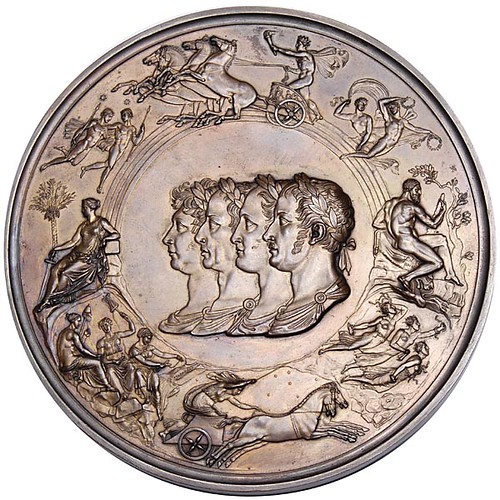
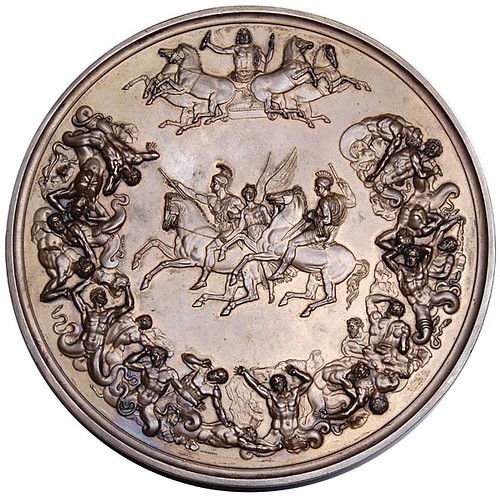
To read the full lot description, see: Lot 1909: Independence Centennial Medal, 1876.
IT'S NOT THE OLYMPIC MEDALS, IT'S THE OLYMPIC METTLE
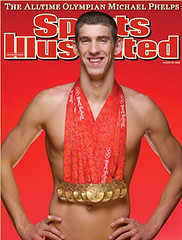 Sports Illustrated shows Michael Phelps posed
with all eight of his Olympic gold medals on the front cover of this
week's issue. A world famous accomplishment - the first ever athlete to
win eight such medallic accolades.
Sports Illustrated shows Michael Phelps posed
with all eight of his Olympic gold medals on the front cover of this
week's issue. A world famous accomplishment - the first ever athlete to
win eight such medallic accolades.They are calling him the 'eighth wonder of the world.' Phelps is destined to earn $10 million just for posing with the eight Olympic gold medals for posters, trading cards and other media. You will see this image many times in the future. I have great admiration for his accomplishment and respect for the athlete's years of training and undoubted self sacrifice to accomplish this feat.
However, the fact he was one-hundredth of an inch ahead of the second swimmer to win his last event seems incongruous to me. How does that miniscule distance relate to $10 million? I will leave the answer to that question to others more knowledgeable about sports races than I.
What I feel is important is the design of the Chinese Olympic medals. They are exceptional, particularly by the including a jade ring on the reverse. And I commented on these when first we learned about their design. (See E-Sylum vol 10, no 35, art 18, Sept 2, 2007.)

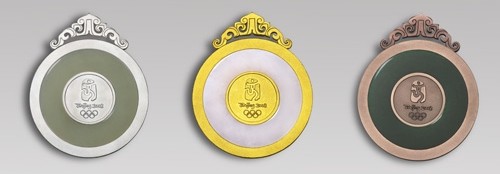
To read the story about the Sports Illustrated cover, see: NOW PHELPS WILL REALLY STRIKE GOLD (http://www.nypost.com/seven/08192008/news/worldnews/
now_phelps_will_really_strike_gold_125083.htm)
To read the earlier E-Sylum article, see: 2008 OLYMPIC MEDALS TO HAVE JADE INSERTS (http://www.coinbooks.org/esylum_v10n35a18.html)
I.O.U.S.A: NUMISMATIC ICONS & U.S. CURRENCY SIGNERS
The film made heavy use of numismatic icons. There were lots of graphics of coins and paper money and many videos of newly printed notes rolling off the printing presses. Also used were graphics comprised of parts of paper money, such as the portraits, building vignettes, and frame engraving.
One of the more surprising interviews was of former Treasury Secretary Paul O'Neill. He claimed that his unwillingness to go along with the Bush Administration's fiscal policy got him fired. Presumably to spare him embarrassment, VP Dick Cheney told O'Neill to issue a press release in which his leave-taking would be presented as a resignation to resume work in the private sector. I only vaguely remember the contemporary reporting on this, but in the interview, O'Neill says he was fired. I think his successor, John Snow, may have met a similar fate.
In the discussion after the film, Warren Buffett sounded like a cheerleader for the American economy, using Buffett's name in the title seems to have worked. The theater was about half full. At $18.00 a ticket, that's not bad.
BRITISH ARCHAEOLOGISTS FINDING COINS OF MANY ERAS AT DIG SITE
 Archaeologists scratching through layers of
history in Worcester have found an ancient Roman coin and a 200 year-old
halfpenny.
Archaeologists scratching through layers of
history in Worcester have found an ancient Roman coin and a 200 year-old
halfpenny. The small coins were once separated by thousands of years, but now sit side by side in the increasingly full exhibition case on show in The Butts.
For the next eight weeks more finds will be added to the glass cabinet as they are unearthed. It is the perfect place to see and start to comprehend just how much history lies under our feet.
Last week, they found three coins. The Roman denarius has been badly eroded making it impossible to date, but you can still make out the image of a Roman emperor stamped on its face.
The halfpenny dates to 1807 when King George III ruled England and slavery was abolished from the British Empire.
The team also dug up a 17th century coin of King Charles reign, indicating that there could be artefacts dating back to the Civil War hidden beneath the surface.
For more information go to wlhc.org.uk.
To read the complete article, see:
(http://www.worcesternews.co.uk/news/local/3606284.Roman
_coin_paints_a_picture_of_city___s_past/)
FEATURED WEB PAGE: CASTINE AND THE OLD COINS FOUND THERE
This week's featured web page is suggested by Ray Williams. It's a reprint of a paper by Joseph Williamson first printed for the Maine Historical Society, 1859, on the topic of the hoard of coins found at Castine, Maine.From the web page:
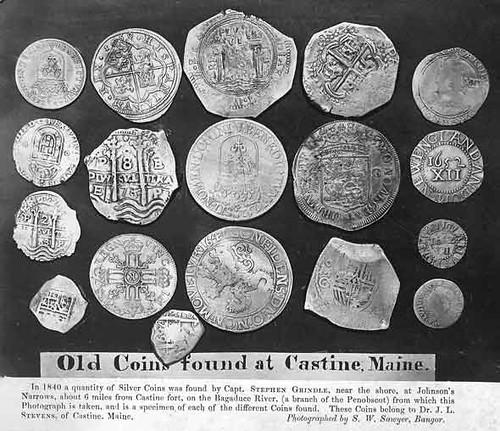
www.wilsonmuseum.org/bulletins/summer2003.html

